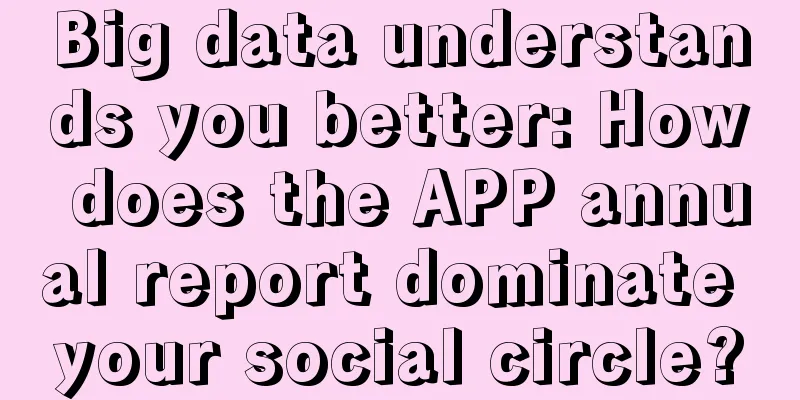Big data understands you better: How does the APP annual report dominate your social circle?

At the turn of the old year, major APPs have released annual reports, recording and presenting every detail of users' lives over the past year, from daily food, clothing, housing and transportation to books, movies and music, successfully inspiring users to share and display on social media, bidding farewell to the past and welcoming the new year through such a special ceremony. The annual report has become a must-have annual marketing ceremony for major platforms. This carnival of sentiment, nostalgia, and companionship is actually a platform that "tailors" empathy "marketing" for users through big data, reflecting that a sense of ritual and belonging are the unchanging rules of platform construction. However, whether ritual marketing at the expense of privacy can continue remains to be seen.
This classic quote by Maupassant should be the true feeling of the majority of netizens in 2022. Life is indeed not easy in the face of the epidemic. However, under the haze of life, people are also trying to retain the beautiful moments of the past. As major apps release their annual reports, "digital memories" about listening to music, reading, short videos, and social networking are flooding in, reminding us that as 2022 draws to a close, don't forget to look back and see what we've experienced this year. These reports are both thoughtful and private, but they do not prevent them from being "popular" in WeChat Moments and becoming a "show-off" asset for users to post on WeChat Moments. Why is this so? Cultural Industry Review will take you to find out. 1. Inventory of annual reports of major content platformsSince NetEase Cloud launched the annual report marketing in 2016, generating annual reports for its own users has become a must-have marketing activity for almost all APPs at the end of the year, and 2022 is no exception. Taking stock of the basic forms and characteristics of the annual reports of major Internet platforms, we can find that the APPs that are "inseparable" in our lives are mainly the following categories: Social media: Weibo is the main representative. The report provides statistics for the whole year, including the time spent on Weibo, special holidays, major Weibo events (such as the Winter Olympics, the World Cup, etc.), and the most frequently used words and Emojis. As a social media, interaction data is naturally indispensable. Weibo reports the bloggers with the highest number of Weibo readers and the netizens who maintain the most interactions, and you can send Weibo @ them with one click. The second half of the report is a habit report, including the day with the most Weibo posts, the number of days you stay up late to browse Weibo, and the number of Weibo posts you have collected. Lifestyle: represented by Meituan and Amap. Meituan and Meituan Waimai took "yellow temperature" as the theme, and used "food temperature, companionship temperature, gift temperature, caring temperature, memory temperature, constant temperature, and continuous temperature" as dimensions to generate reports covering the number of user orders, frequently used addresses, purchased gifts, favorite things, and annual consumption. With the theme of "Travel Calendar", Amap produces information on the number of user searches, the farthest travel areas, places arrived late at night, frequently visited areas, and also reports on the number of low-carbon trips, which is a highlight this year. Music category: The main contestants include NetEase Cloud Music, QQ Music, Kugou Music, etc. This year is the seventh year that NetEase Cloud Music has launched a listening report. QQ Music and Kugou Music continue to follow up, and the content displayed by music apps is similar, covering the number of songs listened to throughout the year, the accumulated time, the distribution of songs by era, the songs still listened to late at night, and the songs with the most single loops. As a latecomer to the annual listening report, QQ Music's highlight this year is the generation of a music "journey train", which takes users on a virtual train to return to their one-year listening journey in the sound of beautiful music. Due to its novel form, QQ Music's annual report this year has enjoyed a huge traffic dividend. The #QQMusicAnnualListeningReport# topic has been read and discussed 250 million times and 230,000 people on Weibo, and it once became a hot search on Weibo. Knowledge books and movies: represented by Douban, WeChat Reading, and Zhihu. Compared with the annual reports of music apps, the annual reports of knowledge sharing apps have simple interfaces and focus more on objective data. WeChat Reading shows the number of days and hours users use WeChat to read books, the number of books they have read and finished, and the notes they have recorded. Douban reviews the number of books and movies they have enjoyed each year, and the book covers and movie posters are scrolled in the shape of scriptures. Zhihu's annual report is relatively simple, with only the thoughtful copywriting and annual keywords in black text on a white background. Consumption bill category: Starring McDonald's, Starbucks, etc. The Starbucks annual bill records the special memories of members ordering Starbucks drinks, including the "One Cup Start Day" for the first order, the "New Discovery Day" for the first exploration of a new Starbucks store, the "Everyone Day" for ordering with everyone, and the "Rich and Willful Day" for the highest order amount. McDonald's counts the number of meals, McDonald's restaurants that check in, and the first McDonald's meal ordered this year, and of course the most favorite food, and sets personality labels such as "foodie" and "gourmet" for users. 2. Big data understands you better: How annual reports are generatedThe generation of an annual report requires three steps: user data production, collection, and processing. It is like the "store" and "workshop" of a factory. The "workshop" interprets, modifies, and packages user data, giving the data a specific meaning. The "store" restores and "displays" user behavior trajectories, habits, and preferences, implicitly emphasizing the presence and importance of the APP in the user's life for a year, and conveying the concept of "understanding you." The first is user data production. When users register to use an APP, it is equivalent to having an online virtual identity on these network platforms. As long as we use these APPs, we start to produce data on the platform. There are three types of data: Explicit behavioral data. Such as personal dynamics, forwarding, comments and chat records on social apps, and personal content posted on UGC platforms. These data show our interactive behaviors with other users and have a direct effect on constructing the user's identity. Implicit behavior data. For example, records of purposeless searches, clicks, and web browsing. Implicit behavior data is often generated by individual user behavior. It is not for the purpose of self-performance, but it can restore specific scenes. For example, if the NetEase Cloud Music annual report tells you that you listened to a class in a loop on a certain night, you can restore the scene at that time. Basic data, such as gender, age, region, education level, etc. These data are stable and can be used to analyze the motivations and reasons for specific user behaviors. Secondly, user data processing. After users generate these behavioral data and static data on the APP, the platform uses an algorithm mechanism and the APP background selects data such as the amount of music listened to, the amount of consumption, and the takeaway order records, and cleans and transforms them through technical means. Combined with the data, it analyzes the user's habits, attitudes, preferences and other potential information, and attaches multiple labels to the user based on the analysis results, identifies the user's characteristics in various aspects, and completes the deepening of the report content to improve the quality of the data. Next, we conduct correlation analysis and extract user features to extract user labels to construct factors such as user habits, interests, and personality. As a result, the user's individual image gradually becomes clearer. The data processing process is also the process of mining the value of data, because behavioral analysis can be used to evaluate the user's consumption capacity and thus establish a marketing strategy. Finally, the user data is presented. As long as the user agrees to the platform's "Privacy Protection Regulations", your data on the platform for the past year can be presented intuitively. The processed data is weighted through multi-dimensional labels to ultimately form a user portrait. In order to more vividly display the user's virtual personality traits and consumption preferences behind the data, in addition to digital display, the user data in the "Personal Annual Report" is mostly visualized in the form of word clouds, user tags, various statistical charts, etc. In particular, in order to highlight the individual characteristics of various APPs and create a good reading experience, the annual reports issued by APPs have various forms in visual design, such as Xiami Music's "Music Photo Gallery", Alipay's personal report in the form of a bill, and Zhihu's annual report combined with fun games. 3. Sense of ritual, identity, and community: Why do APP annual reports dominate social circles?In theory, the APP annual report is a personal account of one's daily life and spiritual consumption over the past year, and is highly personal. However, when you open your Moments, you will find that your friends have already filled the screen with highly personalized annual reports. The reason for this is that it is due to both special nodes and user psychology. First, the end of the year has a special meaning in terms of time. It means that we can recall every detail of the year through a special ceremony, record a wonderful and touching moment, and bid farewell to the old year and welcome the arrival of the new year. In this sense, the annual report screen-sweeping reflects that a sense of ritual is a rigid need of users. The thoughts of @面包, a Zhihu netizen, may have expressed the voice of many people: "In the chaotic year of 2022, I feel that the order and planning of me are constantly broken, and I always face the challenges of life in an unprepared attitude. When I saw the annual report, there were many moments when I felt that I really couldn't solve the problems in front of me, but in the end I actually crawled all the way to the end of 2022." As Borges said, "Any destiny, no matter how long and complex, is actually reflected in only one moment: the moment when people completely understand who they are." Therefore, at the end of the year, what people forward is not a simple report summary, but their own hope. We need these "digital imprints" because they record the unique joys, sorrows, anger and happiness that belong to each of us. Why do platforms need to cultivate a sense of ritual among users? American communication scholar James Carey believes that ritual has the important function of stabilizing the order pattern and is a way to fix certain norms and systems. Starting with NetEase Cloud Music in 2016, the annual report has become a customary year-end ritual between the platform and users. It deepens the sense of year-end ritual at a fixed time and in a fixed way, cultivates users' deepening attention to the APP, and ultimately forms a fixed usage habit. There is a natural return for hard work. On August 18, NetEase Cloud Music released its financial report showing that in the first half of 2022, each daily active user spent an average of about 80.6 minutes listening to music on the NetEase Cloud Music platform, higher than 76.9 minutes in the first half of 2021. As of the end of June 2022, NetEase Cloud Music had 3.4 billion user-created playlists. In the first half of 2022, the number of monthly active users of NetEase Cloud Music's online music service was 181.9 million. Second, self-image presentation. Goffman's "impression management" and "dramatization" theory points out that individuals hope to gain recognition from others by producing specific symbols in cyberspace, thereby achieving self-identity. First of all, the most important functional attribute of the year-end report is to help individuals complete the self-image shaping on the social platform by mining accurate data from all aspects of the user's life. WeChat Moments is equivalent to the "front desk" in the troupe, and users perform on this "front desk" by sharing NetEase Cloud's annual listening report. Secondly, the platform injects subjective emotions into cold objective data, marking an inconspicuous moment in the user's life with "specific meaning" or "personality symbol", helping users to form their own personality labels. After all, in the minds of many users, these apps are not only a piece of software, but also a symbol that can carry their own life taste, and to a certain extent represent the user's demand for quality of life. "High-end", "niche" and "personality" may all be hidden keywords in the playlists posted. Finally, the act of sharing itself is affected by the accumulation of emotional energy. The platform aestheticizes the daily life of users, and the sense of ritual and aesthetics interact to help users satisfy their desire for expression on social platforms. In a semi-anonymous space, they beautify their image by hiding or covering up facts that are inconsistent with their ideal self-image, thereby achieving the purpose of image reconstruction. Third, seek recognition and find a common community. The platform uses big data to present the warmth and warmth of individuals' hearts, and successfully ignites the emotional outburst of individuals with numbers that cannot "speak", making annual reports popular on social platforms. It not only shows one's own online image, but also provides an opportunity for oneself to find "like-minded" friends. When we share the report to Moments, we judge the group that others belong to through this carnival, and at the same time build our own community. According to Maslow's hierarchy of needs theory, "being affiliated" and "being recognized" are common rigid needs of people. The annual report is popular on social media, which is actually a group of people who love sharing sharing with the "right people". In the process of sharing the annual report, turning the long-used APP into a companion who shares weal and woe with you is a typical portrayal of the current online social networking of young people. ConclusionAs an annual marketing event, major APPs release annual user reports and user sharing, which seems to be the result of "collusion" between the platform and the users. The platform sticks to the users through the sense of ritual, and the users get the opportunity to show themselves. But in fact, behind this nostalgic carnival, there are many problems hidden. The first is the issue of the credibility of the report. As the People's Daily criticized, "'empathy' is marketed," the complexity of individual warmth should not be portrayed by data. Secondly, the annual report must be authorized by the user. In my country, the system for protecting personal privacy is not yet sound, and incidents of APP leaking and selling user data are not uncommon. Behind the user's "loyalty" there is also the problem of "big data killing old customers." Finally, regarding the user experience, the annual report can indeed increase user engagement, but “the success comes from daily life”, just as the rise of QQ Music is due to its focus on copyright and content construction, rather than blindly “nostalgia”. However, being able to recall every bit of life in the past year from the annual report may be enough for users. Author: Yi Wuyou; Editor: Shi Guang; Editor: Bandao Source public account: Cultural Industry Review (ID: whcypl), China’s top new media for cultural industry. |
<<: The seven major internet celebrity industries in 2022: Who wins and who fails?
>>: Meituan becomes a store exploration "MCN" to compete for Douyin influencers
Recommend
Does Amazon Mexico accept payments in US dollars? How do I receive payments?
Amazon's Mexican site is one of the North Amer...
What are the requirements for registering and opening a store on Flipkart?
As one of the largest e-commerce platforms in Indi...
How to transfer Amazon products? How much does it cost?
For domestic e-commerce, cross-border e-commerce i...
With a revenue of 6.2 billion in 3 months and a joint venture with Moutai that went viral, how did Niuhulu Luckin Coffee become successful?
This article first briefly introduces the joint ve...
What is the difference between Shopline and Shopify? What is SHOPLINE?
There are many merchants doing cross-border e-comm...
How to edit videos in Wish? How to upload product videos?
As the world's leading mobile e-commerce platf...
The live broadcast sold 25 million in one day. How long can he continue to rely on the traffic of "Searching for Relatives"?
Can amateur internet celebrities find a balance be...
It’s just selling milk tea, is it necessary to be open 24 hours a day?
More than 20 tea brands and 450 stores are trying ...
The ceiling account for women's clothing reviews! 2.45 million followers, and the blogger is a man!
Douyin's ceiling account for women's cloth...
Marketing Calendar | December marketing hot spots are here, find your marketing secret code
The last month of 2023 is here! This article summa...
Connecting the membership system may be the best solution for Meituan
Meituan has expanded its "God Member" pr...
From seeding to conversion, how can brand merchants make e-commerce gold from social media platforms?
A commercial consensus has gradually been reached ...
Joy of Life 2: The Siphon Effect of S-Class Dramas
Joy of Life 2 concluded last night. What can we se...
How to transfer an Amazon store? What information is required for transferring an Amazon store?
In some cases, sellers may need to transfer their ...
It’s time for “classical graphic and text self-media” to change
Known as "classical self-media", they ha...









